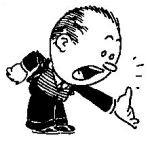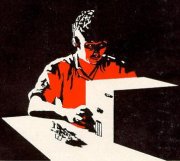Enjoying Radio
The signal faded in slowly, dying away into the background roar, returning.
Jim's heart was pounding so hard it shook him.
"Calling DX."
Thousands of miles of black, tumbling ocean intervened. Outside, the two great towers, outlined irregularly in white, rose up and up into the swirling snow; downstairs, the input reactors sang monotonously in the ghastly glow of the rectifiers. The filaments of the push-pull stage in the 7-mc. amplifier imparted a dull radiance to the polished edges of the neutralizing condenser discs. All were ready, waiting to hurl the dynamite.—from John C. Flippin, W4VT, "Jim," 01935
You see, wire telegraph is a kind of a very, very long cat. You pull his tail in New York
and his head is meowing in Los Angeles. Do you understand this? And radio operates exactly
the same way: You send signals here, they receive them there. The only difference is that
there is no cat.—Albert Einstein
Once a year Jeremy used to aim his highly directional rhomboid antenna up in the direction of Ceres Minor and transmit Indian music. Just for a few minutes. Just to let them know. Just in case they were listening.
You might do the same from time to time. So they can be sure.—Lorenzo W. Milam, Sex and Broadcasting, 01975.
B
y the mid 1880s CE, humankind had discovered and could rudimentarily produce and detect the electromagnetic emissions we now call radio. By World War I, the importance to human society of radio for commerce and defense had enlivened popular culture such that organizations of private, nonprofessional radio experimenters—radio amateurs, later nicknamed hams—had come into being worldwide. In the 1920s, the advent of broadcasting, first via radio wavelengths of hundreds of meters, later on shorter wavelengths found by hams to be more easily capable of spanning intercontinental distances, and later still at the much shorter wavelengths used by FM and television, spawned the hobby of distance listening—DXing, a sport even more energetically enjoyed by hams in two-way form. Even though my father and uncle had been licensed radio amateurs since the 1930s, my boyhood encounter with the how and why of the medium behind radio's message began with my own discovery that each nightfall brought to even the lowliest kitchen AM/mediumwave radio a flood of signals from cities hundreds to thousands of miles away. For me, radio works magic that cannot fail to enthrall.
But ah, what a beautiful thing a well-made rotary was! Here was where dreams were made. Here, in its crashing blue-white spark, was tangible evidence of its might. No matter if it could be heard for blocks—as indeed it could, unless it were put in a double box. No matter if it blinded
the operator as well as made him deaf, and gave him red-rimmed eyes from its vaporized zinc electrodes. What if it did lose most of its energy in light, heat and sound; was it not the visible and mighty heart of radio?—from K. B. Warner, W1EH, "Silver Anniversary," 01940

|
|
|
Amateur Radio W9BRD Then and Now
|
|
The First W9VES
|
|
Amateur Radio W9VES I (01935–01969) and W9VES II (01996–02014)
|
|
Pretend Ham Radio
|
|
How to Get More Time for Ham Radio
|
|
The Marvelous Regenerative Receiver
|
|
A Cascoded-Triodes (Synthetic Tetrode) Regenerative Receiver
|
|
But Not For Voice (Robert S. Kruse, W1BAO, 01936, comparing regenerative receivers for Morse code and voice)
|
|
Celebrating Radio with a Navy RAL-5 Regenerative Receiver
|
|
A Hybrid Pentode-MOSFET Regenerative Mixer
|
|
The Crystalizer: Obtaining Crystal-Oscillator Output at f, Harmonics, and Subharmonics
|
|
A Two-BJT Variable Frequency Oscillator
|
|
Intrinsic Negative Resistance as a Cause of Parasitic Oscillations in Beam Power Tubes
|
|
Celebrating the One-Tube-Oscillator Transmitter
|
|
HC-49-Crystal-Safe Vacuum Tube Transmitter Designs
|
|
Seventy-Five Years of the Boosted Pierce
|
|
A Cautionary Note on the McCoy "Mighty Midget" Transmitter
|
|
Rediscovering the Band-Imaging Receiver
|
|
The full schematic of the Goodman Miser's Dream Receiver
|
|
Notes on R. L. Drake Receivers and Transmitters
|
|
Lowering the CW Receiving Pitch in the Yaesu FR-101 Receiver
|
|
Homemade Equipment Pictures
|
|
It's Been a Great Winter (K. B. Warner, W1EH, 01931)
|
|
Hams We Are (K. B. Warner, W1EH, 01931)
|
|
"I Can't Be Bothered" (R. B. Bourne, W1ANA, 01932)
|
|
Silver Anniversary (K. B. Warner, W1EH, 01940)
|
|
Christmas, 1944 (R. H. Newkirk, W9BRD, 01946)
|
|
The Opening of the Band (R. B. Bourne, W1ANA, 01946)
|
|
Jim (John C. Flippin, W4VT, 01935)
|
|
The Snug Ham Shack in Winter: Harry Hick's December 01956 QST Cover
|
|
Farewell to Monrovia
|
|
Main at Starr
|
|
We returned the midget monster with thanks and eagerly moved back among our economy-sized apparatus, choosing to be surrounded by our station. The v.f.o. is here, the rest of the exciter is up there, the driver is down here, and the final is in there. The t.r. switch is under this, the antenna coupler is over there, and the audio section is around somewhere. The power supplies are well distributed, and we can still monitor our keying by the blue pulsations of picturesque 83s and 816s. The receiver? Here we're even neater. The crystal front end is boxed at left, the tuned i.f. strip is in that one-pound coffee can, and the audio is—well, it may be in that two-pound cookie tin at right. Not sure of those other boxes and chassis till we take another inventory. When the next issue of QST arrives we'll be in there with our soldering stuff to try a suggested circuit or two. Plenty of elbow room, so we won't need a microscope for the job.—the previous W9BRD, "How's DX?," QST, January 01964, page 85.
And now, when the receiver has been built, adjusted, and placed in satisfactory working condition, it will be permissible to sit back and take a long breath. For the receiver is one of the essential parts of the amateur station. It it has been correctly built and if the location of the station is satisfactory it will receive as far as any transmitter can send. If it has open tuning scales; if it has lots of sensitivity and amplification; and if it is smooth and quiet in operation, it will be a very great comfort and a source of splendid pleasure.—The Radio Amateur's Handbook, ARRL, 01929–01933
Well, there you were, except for the gadgets such as blocking
condensers, 'phones, kick-back preventer, change-over switch and
a key with contacts as big as dimes to carry the heavy current.
What could you do with it? You couldn't do much in the summer,
particularly at night, because of the static. You couldn't hear
anything when anybody else was sending in the same town, because
a nearby signal occupied the whole tuner. But given a break, you
could talk for miles, many miles. And given a really good break,
a crisp clear winter night in the wee hours after the young squirts
with the spark-coils had gone to bed, you could have the time
of your life and actually work for hundreds of miles . . . if
the signals didn't fade out, if interference didn't start up,
if you didn't blow a condenser, or if you didn't lose that critical
adjustment. Or if the cops didn't run you in for maintaining a
nuisance, or a wind blow down your masts. And you could investigate
the phenomenon known as kickbacks-in-the-power-wiring and, as
we twice did, set the house on fire. Or the phenomenon known as
corona losses, watching the great fuzzy caterpillars on the high-voltage
parts of your antenna system. Or involve yourself in endless arguments
over high note versus low, what the power factor is in a freely
oscillating circuit, or how loose the coupling ought to be to
obtain a "pure" wave.
Those, our friends, were the days from which amateur radio has
come.—from K. B. Warner, W1EH, "Silver Anniversary," 01940
I've been a ham forever. I thought I'd lost interest in radio, but it turned out that I'd only lost interest in post-modern radio. It's all boring chitchat on overdesigned, mass-produced toys that are obsolete every 9 months. Since just about everyone in industrial countries will soon be wearing global communication on their belt, the romance will inevitably shift from the mere doing of radio to doing it as art. It's already starting, as witness the sudden rush to own any kind of tube radios at all.—Hugh's Ominous Valve Works, The RF Section, encountered in this form on May 22, 01998
Amateur Radio As We Know It Today will come to an end at midnight tonight.—D. Newkirk, WJ1Z, "A 40-Meter Regenerative Receiver You Can Build," QST, September 01992

